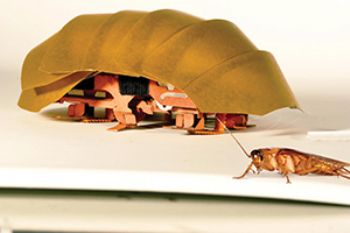
A University of California (UC) Berkeley study of how American cockroaches penetrate the tightest joints and seams in less than a second has led to US scientists designing a small robot that can carry out search-and-rescue operations to find people in disaster areas.
Study leader Kaushik Jayaram said: “What’s impressive about cockroaches is that they can run as fast through a quarter-inch gap as a half-inch gap by re-orienting their legs completely out to the side. They’re about half an inch tall when they run freely, but they can squish their bodies to one-tenth of an inch.”
Using the cockroach technique as inspiration, Dr Jayaram designed a simple palm-sized robot that can splay its legs outwards when squashed; he then capped it with a tough plastic shield similar to the smooth wings covering the back of a cockroach.
Called CRAM (Compressible Robot with Articulated Mechanisms), it was able to squeeze into and run through crevices half its height. Dr Jayaram built his robot using an origami-like manufacturing technique; it is now available as an inexpensive kit made by Dash Robotics,which is a commercial spin-off from previous robotic work at UC Berkeley.
Now, more robust versions will be needed for real-world testing. Robert Full, a professor of integrative biology at UC Berkeley, said: “In the event of an earthquake or an explosion, responders first need to know if an area of rubble is stable and safe, but most robots can’t get into rubble.
However, if there are lots of cracks and vents and conduits, you can imagine using a swarm of these cockroach robots to locate survivors and safe entry points.
“This is only a prototype, but it shows the feasibility of a new direction, using what we think are the most effective models for so-called soft robots — animals with exo-skeletons. Insects are the most successful animals on earth — they intrude nearly everywhere — and we should look to them for inspiration.”
Over the past three decades, Professor Full and his students have studied how animals move to understand the basic bio-mechanical principles that underlie locomotion.
Their findings have inspired robots with legs like those of cockroaches and crabs, as well as sticky feet like those of geckos. In the early 1990s, he discovered that cockroaches can run on two legs and achieve speeds of nearly 5ft per sec.